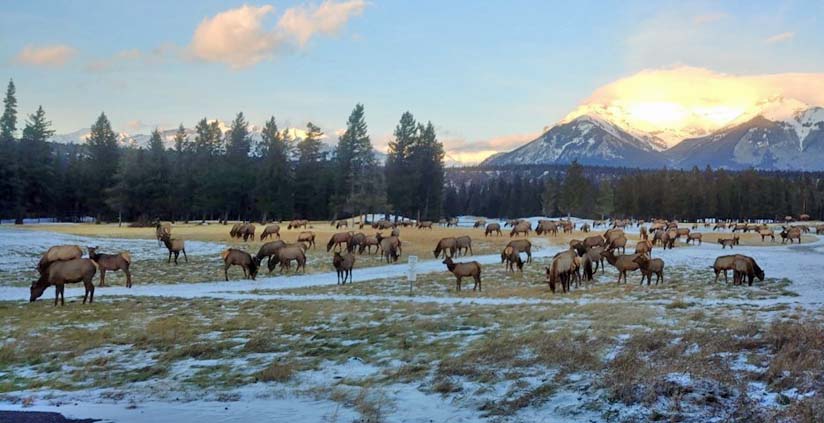
Banff Alberta - Five elk are dead after being hit by a train near the Banff townsite.
Parks Canada wildlife experts responded to a report from Canadian Pacific Railway (CP) around noon on 2 Mar 2022 that a train had struck up to seven
elk on the tracks between the industrial compound and townsite.
"We went out to investigate and we found two elk that were killed instantly by that collision. We found three others that were injured and had to
be euthanized for animal care reasons," said Dan Rafla, a human-wildlife coexistence specialist for Banff National Park.
Two other elk appeared to have minor injuries, but were able to move about.
The elk were monitored throughout the following days to see how they were faring.
"In the end, there were a total of five animals killed in that one strike, which is a bit unusual to have that many, particularly in that
section of track," said Rafla.
The incident could not be attributed to anything in particular.
It occurred in daylight hours, along a relatively straight section of tracks, and it wasn't snowing or raining to affect visibility.
"I suspect, given enough time and exposure to the track, you will have events like this every so often," Rafla said.
The dead and injured elk were part of a larger herd of about 30 or 40 individuals travelling in the area.
"There might have been panic, and animals in the back didn't necessarily know what was going on, and the train was upon them," said
Rafla.
With larger male bears expected to emerge from their dens any time now, and the train accident backing up onto residential neighbourhoods, Parks
Canada resource conservation officers removed the elk carcasses.
They didn't want to draw carnivores such as wolves or cougars close to town, wanting to avoid potential serious encounters with people.
"We're beginning to overlap with bear season, so we wanted to make sure we're not leaving any carcasses," said Rafla.
"It was essentially the backyard of some residents, particularly people who are living there, or walking their dogs, or
commuting."
Pathology samples were taken from the elk to test for disease and overall health.
A natural bacterial disease has killed a handful of elk in the last couple of years.
These are the first documented cases of a clostridial disease in elk in Canada, although that doesn't mean the disease is only found
here.
"When we have mortalities we do a suite of samples seeking to look at wildlife health in general," said Rafla.
Banff's elk population has been declining in recent years.
The 2021 fall classification between the east park gate and Castle Mountain counted 171 elk, which is down from 212 in 2020, 249 in 2019, 267 in
2018, and 229 in 2017.
Last year's numbers were the second lowest since the count began in 1985.
The lowest was 128 elk in 2002, shortly after hundreds of elk were trapped and shipped out of town.
Relocating so many elk aimed to reduce the high number of elk attacks and aggressive encounters in the 1990s and restore natural ecosystems that had
been disrupted by an overabundance of elk in one area.
Rafla said the current elk numbers are within the 150-300 elk population target for the Bow Valley of Banff National Park.
He said bi-annual elk surveys and cow-calf ratios are used to assess trends.
"When we have mortalities like this, especially when it's a mass casualty event, the event itself may not have an impact, but the cumulative
impacts can have an impact on the population, and you need to pay attention. I don't think we're at a stage where alarm bells are ringing," he
said.
Of the elk killed in the train strike, many were breeding-age adult females.
"When you lose a younger adult female, you lose capacity to have young every year as opposed to a young-of-year calf being struck, it has
different implications. Obviously with the impact in your ecosystem with predation, and natural deaths, and potentially other human-caused deaths,
that can over time have a cumulative negative impact on the population," said Rafla.
Winter overall can be a source of high mortality for ungulates, not just from predators such as cougars and wolves, but also natural environmental
conditions.
"They are under additional stress at this time of year," said Rafla, urging residents and visitors to give the elk lots of
space.
"You should always respect their space, but just recognize it's been a long winter, they've lost a lot of their fat reserves."
Heading into spring, it is not overly uncommon for elk to fall through melting ice on rivers.
In some cases, excited tourists have inadvertently panicked elk, forcing the animals to flee onto the Bow River close to town, and the ice has given
way.
"Do not approach elk, especially if it's along these water sources. If they are forced onto the ice, it may create risk to them, so please just
give them extra space," said Rafla.
Parks Canada asks that elk sightings within the townsite be reported to Banff National Park dispatch 403-762-1470.
Reports of dead, sick, or injured elk should also be called in.
Cathy Ellis.
(there was no image with original article)
(usually because it's been seen before)
provisions in Section 29 of the Canadian
Copyright Modernization Act.
